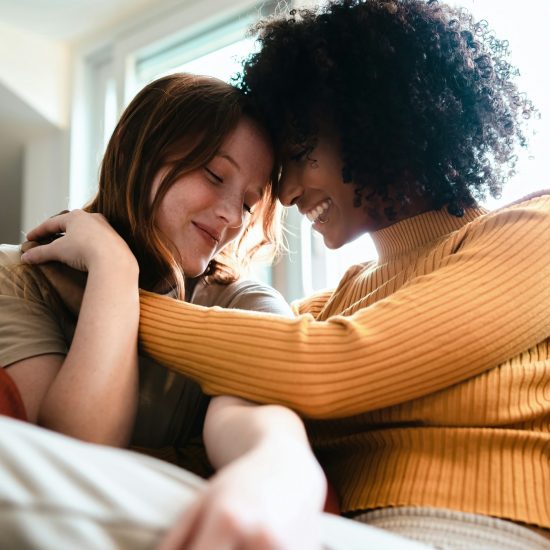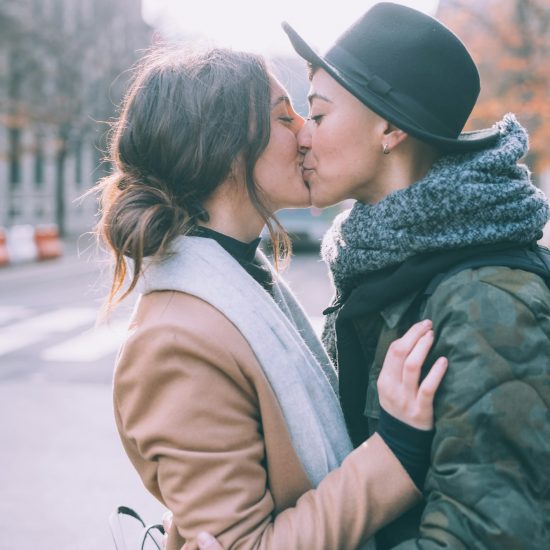Same-Sex Couples
In separate lines of research, Dr. John Gottman and Dr. Julie Schwartz Gottman have observed the strength and resilience of same-sex couples, even in the midst of the cultural and social stresses to which same-sex couples are uniquely vulnerable. These couples — like all couples — need and deserve tailored, research-based support when they are in distress.
Together, the Gottmans have a commitment to assuring that gay and lesbian couples have resources to help strengthen and support their relationships. Dr. Julie Schwartz Gottman made a key contribution to research on daughters of lesbians: her work showed that daughters with lesbian moms do just as well as those raised by straight moms. Dr. John Gottman conducted the first longitudinal study of its kind of gay and lesbian relationships using multiple methods and measures. He was able to assess the emotional strengths and weaknesses of the relationships and to learn what makes these relationships more or less stable.
What Makes Same-Sex Relationships Succeed or Fail?
Dr. Gottman and his colleagues conducted a twelve-year study of same-sex couples to learn what makes same-sex relationships succeed or fail. The research demonstrates that all couple types—straight or gay—have many of the same problems and the same paths to staying happy together. But research has shown that there are also some qualities of strength (like humor and the ability to calm down during a fight) that are especially key to same-sex couples.
Read more about this research in the “Journal of Homosexuality” here.

The 12-Year Study
Using state-of-the-art methods while studying 21 gay and 21 lesbian couples, Dr. John Gottman and Dr. Robert Levenson have learned what makes same-sex relationships succeed or fail.
One key result: Overall, relationship satisfaction and quality are about the same across all couple types (straight, gay, lesbian) that Dr. Gottman has studied. This result supports prior research by Lawrence Kurdek and Pepper Schwartz: They find that gay and lesbian relationships are comparable to straight relationships in many ways.
“Gay and lesbian couples, like straight couples, deal with everyday ups-and-downs of close relationships,” Dr. Gottman observes. “We know that these ups-and-downs may occur in a social context of isolation from family, workplace prejudice, and other social barriers that are unique to gay and lesbian couples.” The research uncovered differences, however, that suggest that workshops tailored to gay and lesbian couples can have a strong impact on relationships.
Read the full article, titled “Observing Gay, Lesbian and heterosexual Couples’ Relationships – Mathematical modeling of conflict interactions,” in the Journal of Homosexuality here.

Results from the Gottman Gay/Lesbian Couples Study
Gay/lesbian couples are more upbeat in the face of conflict. Compared to straight couples, gay and lesbian couples use more affection and humor when they bring up a disagreement, and partners are more positive in how they receive it. Gay and lesbian couples are also more likely to remain positive after a disagreement. “When it comes to emotions, we think these couples may operate with very different principles than straight couples. Straight couples may have a lot to learn from gay and lesbian relationships,” explains Gottman.
Gay/lesbian couples use fewer controlling, hostile emotional tactics. Gottman and Levenson also discovered that gay and lesbian partners display less belligerence, domineering, and fear with each other than straight couples do. “The difference on these ‘control’ related emotions suggests that fairness and power-sharing between the partners is more important and more common in gay and lesbian relationships than in straight ones,” Gottman explained.
In a fight, gay and lesbian couples take it less personally. In straight couples, it is easier to hurt a partner with a negative comment than to make one’s partner feel good with a positive comment. This appears to be reversed in gay and lesbian couples. Gay and lesbian partners’ positive comments have more impact on feeling good, while their negative comments are less likely to produce hurt feelings. “This trend suggests that gay and lesbian partners have a tendency to accept some degree of negativity without taking it personally,” observes Gottman.
Unhappy gay and lesbian couples tend to show low levels of “physiological arousal.” This is just the reverse for straight couples. For straights, physiological arousal signifies ongoing aggravation. The ongoing aroused state—including elevated heart rate, sweaty palms, and jitteriness—means partners have trouble calming down in the face of conflict. For gay and lesbian couples this lower level of arousal shows that they are able to soothe one another.
Gottman Method Couples Therapy Established as Evidence-Based Treatment for Same-Sex Couples
In September of 2017, Certified Gottman Therapist Salvatore Garanzini and Alapaki Yee, MFT, along with Drs. John and Julie Gottman, published the results of the first outcome research study on couples therapy with gay and lesbian couples in the Journal of Marital and Family Therapy. The results proved that Gottman Method Couples Therapy is incredibly effective as an evidence-based therapy for gay and lesbian couples. Working with couples at the Gay Couples Institute, Yee and Garanzini discovered that gay and lesbian couples who received Gottman Method Couples Therapy improved over twice as much as most couples. Most couples therapy outcome studies show that couples tend to improve half a standard deviation, or 0.5. However, couples who took part in the study at the Gay Couples Institute improved approximately 1.2 standard deviations. These results happened with nearly half the number of sessions that is typical for heterosexual couples. This outcome study is the first of its kind, and all of the authors are proud to display the strengths of gay and lesbian relationships to the scientific community, given the current worldwide political climate toward same-sex relationships.
Gay and Lesbian Differences in Emotional Expressiveness
In a fight, lesbians show more anger, humor, excitement, and interest than conflicting gay men. This suggests that lesbians are more emotionally expressive—positively and negatively—than gay men. This result may be the effect of having two women in a relationship. Both have been raised in a society where expressiveness is more acceptable for women than for men, and it shows up in their relationships.
Gay men need to be especially careful to avoid negativity in conflict. When it comes to repair, gay couples differ from straight and lesbian couples. If the initiator of conflict in a gay relationship becomes too negative, his partner is not able to repair as effectively as lesbian or straight partners. “This suggests that gay men may need extra help to offset the impact of negative emotions that inevitably come along when couples fight,” explains Gottman.

